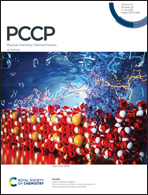First-principles-based kinetic Monte Carlo simulations of CO oxidation on catalytic Au(110) and Ag(110) surfaces†
Abstract
At the core of the development of more efficient and reliable fuel cells (FCs), there are several essential chemical reactions, namely carbon monoxide (CO) oxidation. This reaction is a keystone in the cleaning of hydrogen fuel used in fuel cells due to strong poisoning by this species of the platinum catalyst used in these devices. The present work aims to provide insight regarding the activation of CO oxidation by gold or silver microfacets possessing low coordinated atoms. To achieve this, density functional theory (DFT) quantum calculations, which determined two competing reaction pathways for CO oxidation, i.e., by molecularly adsorbed oxygen, and by dissociated oxygen, are combined with first-principles kinetic Monte Carlo (1p-kMC) simulations, which employed the resulting DFT parameters in order to address the effect of temperature and partial pressures and the interplay of the elementary reaction events. The use of 1p-kMC is a step further from available works regarding the CO oxidation on gold- and silver-based catalysts for cleansing of hydrogen that is used as a fuel in FCs. Indeed, this research contributes to the conclusion that CO oxidation should preferentially occur on silver microfacets, while the obtained turnover frequencies (TOFs) reinforced such a conclusion.



 Please wait while we load your content...
Please wait while we load your content...